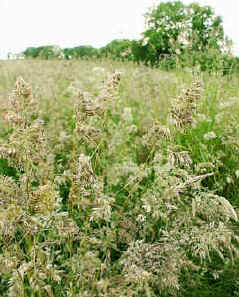
MEADOWS
Meadow Plants

| The dominant plants of meadows are native, rather than
cultivated, grasses, interspersed with a great variety of different herbaceous flowering
plants. Most of the plants growing in meadows are fairly common species also regularly
found in other habitats. With the notable exceptions of certain now rare species such as
orchids, fritillaries and cowslips, the main value of meadows lies in the sheer diversity
of their plant life. This affords a local concentration of a wide variety of invertebrate
food plants, together with shelter for a great many different invertebrate species. This
in its turn means that there is an abundance of food for birds and mammals.The actual
plant species composition of meadows will vary from area to area, depending on local
geological, soil and climatic conditions. The meadow plants discussed here are those
characteristic of lowland meadows in Devon, Southwest England. Dry Hay Meadows These are characterized by mixures of grasses such as Cocksfoot (Dactylis glomerata), Timothy (Phleum pratense), Common Bent (Agrostis capillaris), Sweet Vernal-grass (Anthoxanthum odoratum) and Crested Dog's-tail (Cynosurus cristatus). While grasses may appear to be superficially similar when they are not flowering, once the flowering heads appear the differences become much clearer.
|
||||||
The grasses provide the basic architecture of the meadow. Over the years, thick mats of old, dead, fibrous foliage build up underneath the current year's growth. This provides a large reservoir of decaying material for recycling, as well as winter shelter for a great variety of invertebrates. The grasses are also the foodplants of many of the meadow butterflies. One grass is definitely not the same as another from a caterpillar's view point. Some butterflies, such as the Marbled White, need a mixture of native grasses growing in the same area because the caterpillars favour different grass species at different stages of their growth.
|